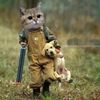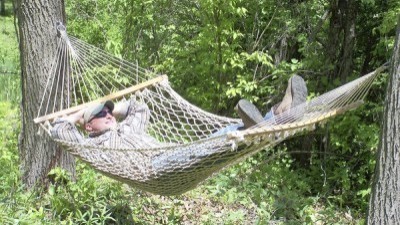Getting prepped for spring
Apr 4, 2019 16:14:23 #
It looks like spring has arrived here, so I thought I had better get ahead of the game since there is already some mowing needing to be done around here.
So, I went out to the shed and my lawnmower, weedeater, backpack sprayer, and lawn chemicals are all there.
I figger that's a good start, so I'm calling it a day. Tomorrow, maybe I'll see if the lawnmower will start.
Can't hurry this stuff dontcha know!
So, I went out to the shed and my lawnmower, weedeater, backpack sprayer, and lawn chemicals are all there.
I figger that's a good start, so I'm calling it a day. Tomorrow, maybe I'll see if the lawnmower will start.
Can't hurry this stuff dontcha know!

Apr 4, 2019 17:21:47 #
archie bunker wrote:
It looks like spring has arrived here, so I though... (show quote)
I am ahead of you. I mowed my yard today.
Apr 4, 2019 17:38:34 #
archie bunker wrote:
It looks like spring has arrived here, so I though... (show quote)
We've got thousands of future landscapers at the border just aching for a chance to cut your grass.
I'm about to make a deal with my cousin for enough stone to build two hundred feet of wall at the South entrance to the property.
I was thinking of going to the border and rustle me some wetbacks to do the job.
Apr 4, 2019 20:42:48 #
archie bunker wrote:
It looks like spring has arrived here, so I though... (show quote)
Weedeater = weedwhacker?
Apr 4, 2019 21:27:53 #
Canuckus Deploracus wrote:
Weedeater = weedwhacker?
Weed/grass cutterdowner. That uses heavy duty fishing line.

Apr 4, 2019 21:44:06 #
archie bunker wrote:
Weed/grass cutterdowner. That uses heavy duty fishing line. 

Yep... That's the one....
Had a dog that used to go beserk around that thing when I was younger... Made the chore more Interesting...
Apr 5, 2019 02:25:04 #
Apr 5, 2019 15:16:31 #
Wolf counselor wrote:
We've got thousands of future landscapers at the border just aching for a chance to cut your grass.
I'm about to make a deal with my cousin for enough stone to build two hundred feet of wall at the South entrance to the property.
I was thinking of going to the border and rustle me some wetbacks to do the job.
I'm about to make a deal with my cousin for enough stone to build two hundred feet of wall at the South entrance to the property.
I was thinking of going to the border and rustle me some wetbacks to do the job.
I use a sun splash Henry. I never miss with that one. You might want to plant the stuff that they say will be off the shelves soon. Yeah, I heard Trump extend closing the border for a year. That chowderhead, it's a crisis.
Apr 6, 2019 03:03:45 #
archie bunker wrote:
It looks like spring has arrived here, so I though... (show quote)
———————
Why mow the yard if you can pay someone else to mow it for you? Besides, 20 years ago, my orthopedic surgeon ordered me to stop mowing my lawn because by continuing to do so would aggravate my already bad back. (I have: degenerative disc disease of my entire spine; scoliosis, spinal stenosis, and rheumatoid arthritis.) I’ve had 3 lumbar spinal surgeries and 1 three-level cervical fusion surgery. The degenerative disc disease has caused my spinal discs to disintegrate on their own. This has caused my vertebrates to collapse onto most of my spinal nerve roots, which is very painful. Of the 23 discs in the human spine, I have 5 that still function. The rest have disintegrated and the vertebrae have fused together naturally. Looking at my soine from the top down, it resembles a corkscrew.
The surgery that would be required to correct my spinal issues would be a major surgery and take multiple surgeries. Even at that, my doctor says he doesn’t believe the odds for success, at present, are any better than 50/50. And, that’s not good enough for him to want to operate.
In addition to my bad back, back in 2015, I had both of my hips totally replaced. Unfortunately, 3 weeks ago, I had to have hip replacement revision surgery on my left hip. It seems that over the past few years since the right hip was replaced, heterotopic ossification has occurred in the left hip.
Heterotopic ossification is the word used to describe bone that forms in a location where it should not exist. Heterotopic ossification generally means that bone forms within soft tissues, including muscle, ligaments, or other tissues.
Often abbreviated "H.O.," heterotopic ossification can occur just about anywhere in the body. Heterotopic bone often forms after surgery, injury, or sometimes for unknown reasons.
The most common symptom of heterotopic ossification is stiffness of a joint. Most people who develop heterotopic ossification cannot feel the a******l bone, but notice the bone growth getting in the way of normal movements. Heterotopic bone often forms around the hip or elbow joints, making bending of these joints difficult. Other symptoms may include a mass that can be felt, deformity of the area, or pain.
Heterotopic ossification occurs when the body gets signals mixed up, and bone cells begin to create new bone outside of the normal skeleton. The body constantly makes new bone to replace bone within the skeleton. When fractures occur in the bone, new bone is formed to heal the damaged bone. In people with heterotopic bone formation, a similar process takes place, but often for an unknown reason.
The process of new bone formation is called skeletogenesis. When this process occurs outside of where normal bone should exist, the result is called heterotopic ossification. The consequences can range from inconsequential to severe. In some cases, heterotopic bone will only be noticed because an x-ray was done for an unrelated concern. In others, the results can limit an individual's ability to perform even simple activities, such as walking.
There are several causes of heterotopic bone formation. These include: Genetic conditions (such as fibrodysplasia ossificans progressiva and progressive osseous heteroplasia)
Surgical procedures (including total hip replacement, elbow fracture, and forearm fracture surgery)
Brain or spinal cord injury (traumatic brain injury and spinal cord injury)
Sports injuries (myositis ossificans)
Treatment of heterotopic ossification is difficult, as little is understood about what triggers this condition to occur. Because there is little understanding of why heterotopic bone may form, it's difficult to know how to prevent additional bone from forming.
Surgical removal of heterotopic bone is possible in patients whose heterotopic bone is the result of surgery or trauma (brain and spinal cord injury patients). Generally, the recommendation is that their heterotopic bone should fully mature, meaning that no additional bone is forming. At that point, surgery may be considered to remove the bone. This is usually performed to allow movement of a joint that had frozen as a result of the bone formation.
In patients who have a genetic disorder that has caused the heterotopic bone to form, surgery is the wrong treatment. In fact, in these patients, performing surgery to remove the a******l bone may worsen the overall condition.
Research is being done to determine if there are genetic treatments to alter the expression of genes seen in patients who have heterotopic ossification. These treatments are in the earliest stages of investigation.
Another issue I had with my right hip was the unexpected discovery of Synovial osteochondromatosis. SOC is a benign condition characterized by synovial membrane proliferation and metaplasia.and metaplasia. The entity also is termed synovial chondromatosis. The synovial lining of a joint, bursa, or tendon sheath undergoes nodular proliferation, and fragments may break off from the synovial surface into the joint. There, nourished by synovial fluid, the fragments may grow, calcify, or ossify. The intra-articular fragment may vary in size from a few millimeters to a few centimeters.
Either issue can and does cause severe pain and a dramatic reduction in limb function and mobility.
Now, you know why I don’t mow my lawn.
Apr 6, 2019 12:21:58 #
alabuck wrote:
——————— br br Why mow the yard if you can pay som... (show quote)
OMG poor you!!!! I'm completely certain you'd rather be mowing your lawn and skip all those awful conditions. So, so sorry you're going through that


Apr 6, 2019 13:03:02 #
alabuck wrote:
——————— br br Why mow the yard if you can pay som... (show quote)
Well, that one kept my lips moving for awhile!
As you know, I'm aware of your condition, and truly sympathetic. I would come mow for nothing if I could, but there is a mileage issue. You don't live just down the block.
I really don't mind the mowing so much at all, and neither does Mrs. Bunker. It's the getting it all down to a maintenance level that I h**e. It's my own fault for being lazy all winter (every year) but once there it's all good. There are fencelines, edges, and areas that I don't want to mow to spray. I have several large bald areas that need to be planted from our two large dogs' constant wrestling matches. These will have to be fenced off until grass is established once again. It's just a lot of WORK!
Once I break the spell that laziness has on me it'll be fine!

I actually plan on doing a lot of watering this year since I have a new pump in my well, and I know there's plenty of water there. That way, I can mow even more!

If you want to reply, then register here. Registration is free and your account is created instantly, so you can post right away.







